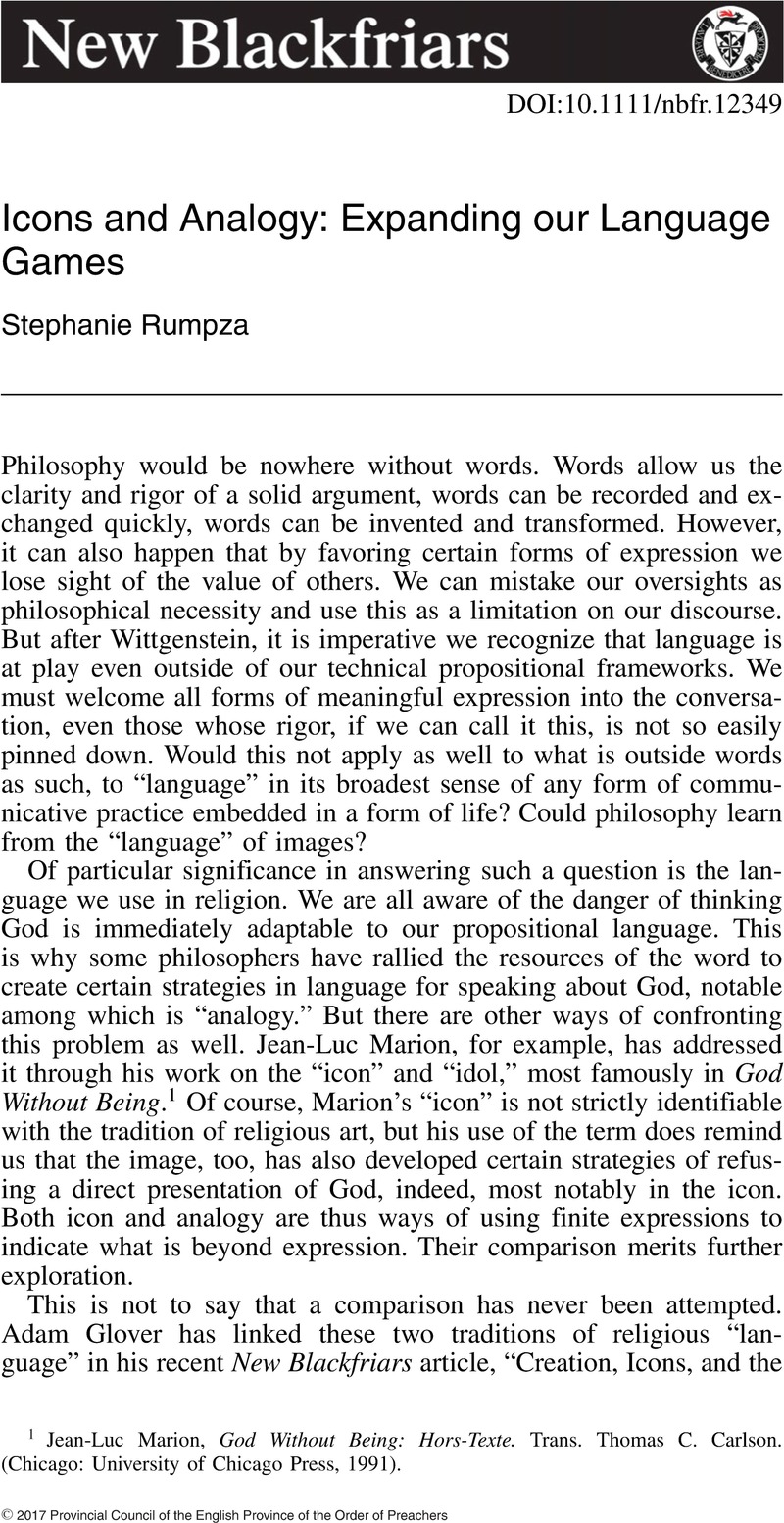No CrossRef data available.
Article contents
Icons and Analogy: Expanding our Language Games
Published online by Cambridge University Press: 01 January 2024
Abstract

- Type
- Original Article
- Information
- Copyright
- Copyright © 2017 Provincial Council of the English Province of the Order of Preachers
References
1 Marion, Jean-Luc, God Without Being: Hors-Texte. Trans. Carlson, Thomas C.. (Chicago: University of Chicago Press, 1991)Google Scholar.
2 Glover, Adam, “Creation, Icons, and the Language of Poetry” New Blackfriars 97 (2016), pp. 529-546CrossRefGoogle Scholar.
3 Glover 533, adapting the term as used by Guite, Malcolm, Faith, Hope, and Poetry: Theology and the Poetic Imagination (Burlington, VT: Ashgate, 2010), p. 104Google Scholar.
4 Aquinas, for one, repeatedly criticizes Maimonodes on this point, e.g. ST I Q13 A2. For a more contemporary conversation, consider the enormous debate surrounding the religious status of Wittgenstein's Tractarian silence: is it a respectful passing over of a truth too great to say? Or a refusal to speak because there is nothing to speak about? Whether or not one believes it is possible to definitively answer this question (perhaps through appeals to other sources), it remains a fact that the silence of the Tractatus at least initially seems to allow for both of these responses.
5 Boston, Karen, “The Power of Inscriptions,” Icon and Word: The Power of Images in Byzantium. Studies Presented to Robin Cormack. (Ashgate: Ashgate Publishing, Ltd., 2003), p. 42Google Scholar. Boston includes some analysis here of how the historical emergence of this title has a complicated history as a visual response to heretical and iconoclastic Christologies.
6 Many authors have described these conventions in detail. See for example Sendler, Egon, The Icon: Image of the Invisible. Elements of Theology, Aesthetics and Technique. Trans. Bingham, Stephen. (Redondo Beach, Calif.: Oakwood Publications, 1995)Google Scholar.
7 Marion speaks of the icon in relation to the tradition of religious images primarily in The Crossing of the Visible, trans. James K. A. Smith (Stanford: Stanford University Press, 2004). This however extends to a broader philosophical understanding of “icon” in his earlier God Without Being; and later in In Excess: Studies of Saturated Phenomena, trans Robyn Horns and Vincent Berraud (New York: Fordham University Press, 2002); and the first edition of his Gifford Lectures, Givenness and Revelation. Trans Stephen E. Lewis. (Oxford: Oxford University Press, 2016).
8 Marion speaks of this phenomenon in frequently, but especially clear expositions can be found in especially pp 116-117 of “The Icon or the Endless Hermeneutic” from In Excess; especially pp. 56-61 of “The Blind and Shiloh” in The Crossing of the Visible; and “The Intentionality of Love” in Prolegomena to Charity, trans. Stephen E. Lewis (New York: Fordham University Press, 2002), pp 71-101.
9 Marion, God without Being, p. 8.
10 Glover, 532.
11 Here I object to Glover's interpretation of Marion. He perhaps too quickly interprets Marion's use of the word “visibility” to indicate what is seen by the senses and “invisibility” as what transcends them. Perhaps this is why he does not account for the problem of the “vertical” axis which Marion is grappling with. The idol and icon for Marion are not primarily a matter of proper reference, or visibility and invisibility in the literal sense, but of the origin of initiative. If it comes from us and the devices available to us it is an idol; if it comes from the divine and what far exceeds our abilities it is an icon.
12 Although the basic similarity is sufficient for my purposes here, the reader may be interested in Merold Westphal's proposal that these motifs of gaze and voice are not exactly parallel. “Phenomenology and Theology in the Work of Jean-Luc Marion,” International Journal for Philosophy of Religion, Vol. 60, No. 1/3 (2006), pp. 117-137Google Scholar.
13 Mulhall, Stephan, The Great Riddle. Wittgenstein and Nonsense, Theology and Philosophy. (Oxford: Oxford University Press, 2015)CrossRefGoogle Scholar.
14 My more detailed challenge of Marion on this point will be forthcoming.




